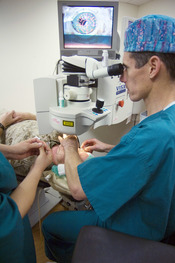Lasik eye surgery is nothing new to the medical world, but it has only been practiced in the United States since 1996. The procedure is suited to anyone who is tired of their contacts or eye glasses, or anyone with a career that prevents the use of conventional vision correction. Lasik surgery is expensive and not all patients may experience perfect results, but it still stands as one of the most technologically advanced methods of eye care. Anyone interested in Lasik as an option should first know how it works, the possible risks and side effects of the procedure, and the impact is has upon society.
Lasik is actually an acronym for "laser-assisted in situ keratomileusis" and is the most commonly performed refractive surgery procedure. It is popular because of its advantages over other procedures, such as a relative lack of post-operative pain and the fact that good vision is usually achieved almost immediately or within a day.
An instrument called a microkeratome is used to create a thin, circular flap in the cornea of the eye. The surgeon folds the flap back out of the way, and then removes some corneal tissue underneath using an excimer laser. The excimer laser uses an ultraviolet light beam to precisely remove very tiny bits of tissue from the cornea in order to reshape it. When the cornea is reshaped correctly, it works better to focus light into the eye and onto the retina, thus providing clearer vision than before. The flap is then laid back in place to cover the area once the corneal tissue is removed. Both nearsighted and farsighted people can benefit from lasik surgery. In people with nearsightedness, the goal is to flatten the too-steep cornea. In those with farsightedness, a steeper cornea is desired. Excimer...


